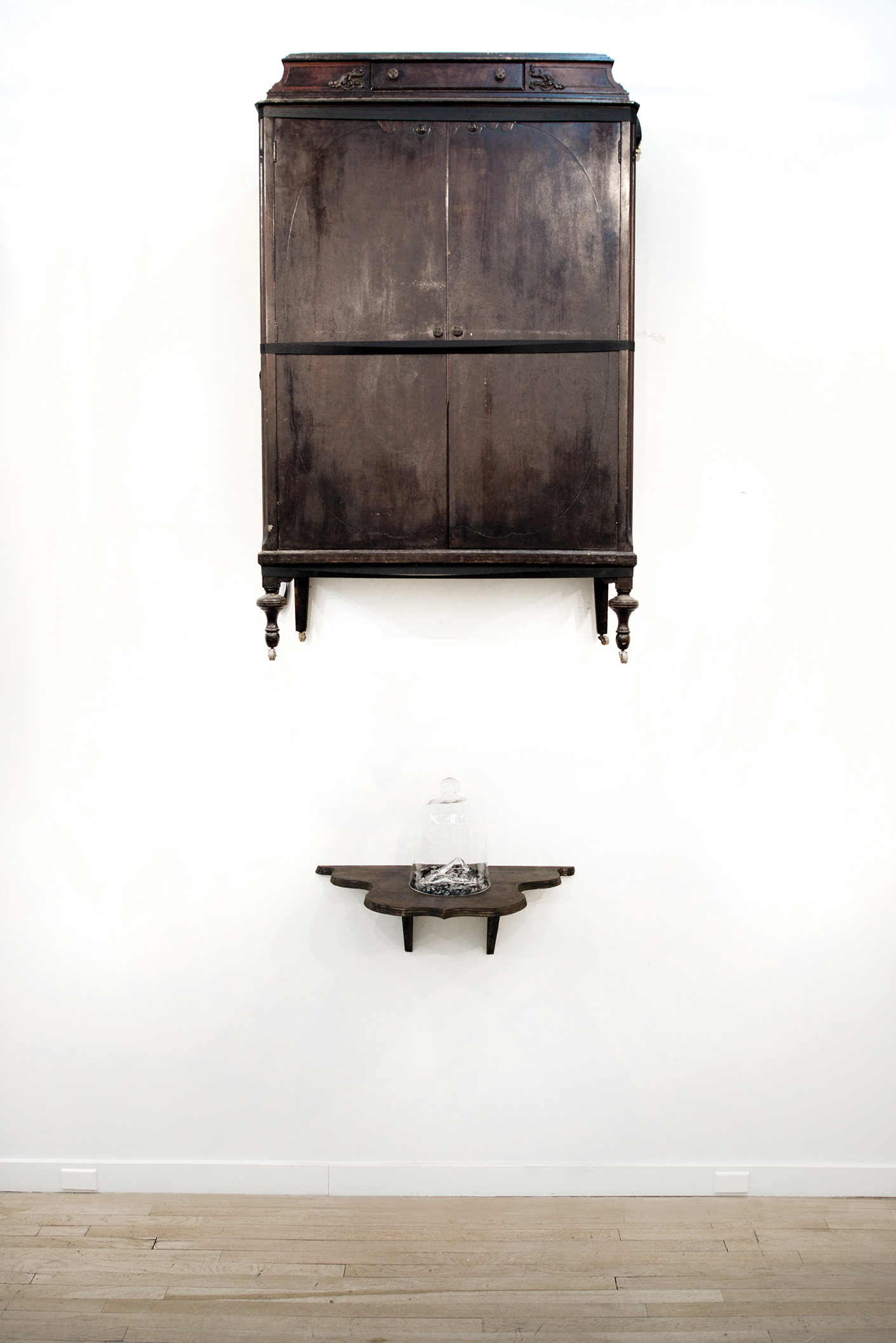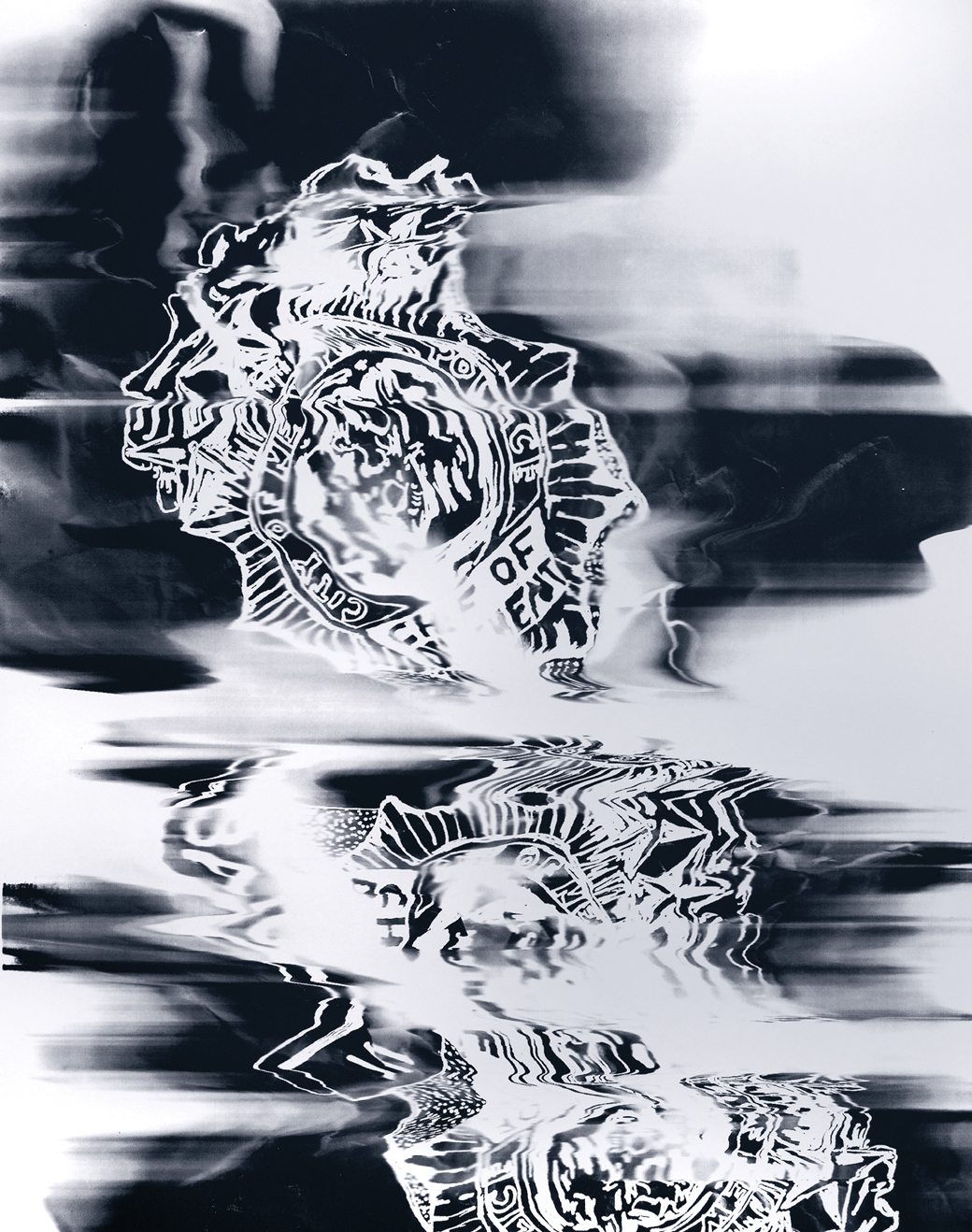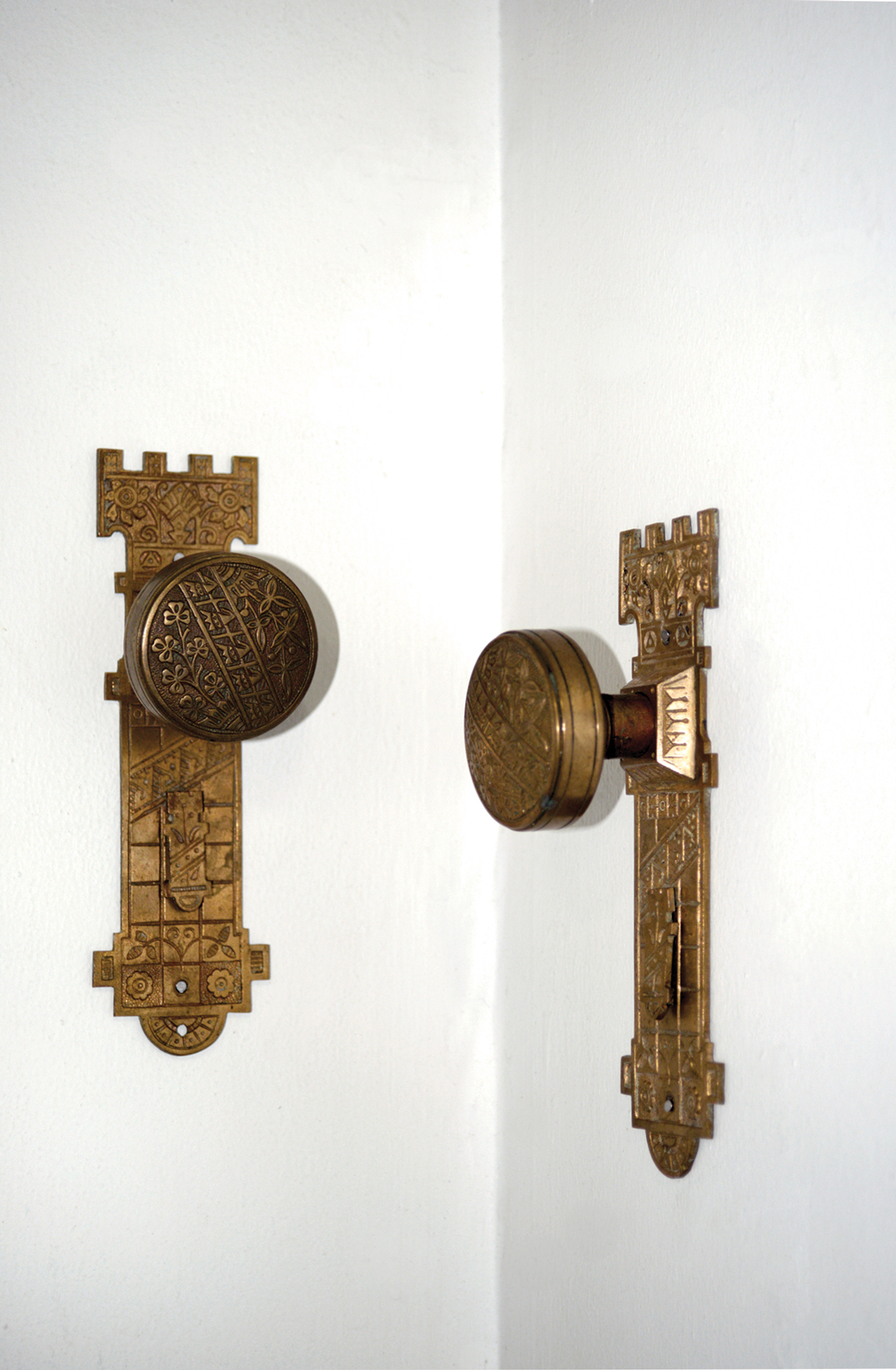
Kambui Olujimi. Mercy Doesn’t Grow on Trees, 2016. Wood, glass, hair, gold leaf, ratchet straps, 12.5’ x 4’ x 2.5’. Courtesy CUE Art Foundation, New York. © Kambui Olujimi.
Presently, there is no system that tracks the number of extrajudicial killings of civilians by police officers in this country. There is no annual tally of the victims, no final evaluation outlining who, what, when, or why. There are only approximations and estimates. What we must do, then, is draw conclusions based on what is reported and shared publicly. When the smoke clears after such an event, we are most often presented with this scenario: police officer shoots/strangles/chokes unarmed civilian. Or more emphatically: White police officer shoots/strangles/chokes unarmed civilian of color. This was Oscar Grant’s story, Tanisha Anderson’s story, and Eric Garner’s story. What often results is a fraught relationship between communities and the individuals responsible for their safety.
In a city such as New York, this tension is palpable. Black and brown neighborhoods have long voiced disdain toward the police, the “men in blue.” Still, the sustained physical threat of violence at the hands of the state is only one of the ways in which New York City’s most vulnerable citizens suffer. As costs of living rise and wages remain stagnant, poor communities of color must also contend with the consequences of economic travails such as joblessness and dislocation, negotiating the politics of a city in which they continue to be pushed to the outskirts.

Kambui Olujimi. Never the Best Time to Retire, 2016. Silkscreen, 60” x 50”. Courtesy CUE Art Foundation, New York. © Kambui Olujimi.
This situation, however, does not dissuade community members from making attempts to extend the olive branch. Nor should one assume that police officers have no connections to the neighborhoods that are most threatened. If nothing else, the processes that shape community relations are complex.
The works that comprise Kambui Olujimi’s exhibition, Solastalgia, reckon with the intersections of these factors. Olujimi approaches the dialogue between policing and community from a personal vantage point that humanizes the institutional and names the abstract. The neologism solastalgia refers to the feeling of dislocation in one’s home environment, when the changes to that environment have rendered it foreign or unrecognizable. Olujimi, who was born and raised in the Bedford-Stuyvesant neighborhood of Brooklyn, appropriates the term, coined by the Australian philosopher Glenn Albrecht, to consider his emotional response to the changes occurring throughout New York City. Indeed, Olujimi’s work speaks to the city’s ever stratifying shifts.
The artist’s process of introspection begins with a series of monochromatic ink paintings of Catherine Arline, his late neighbor and mentor—although that word does not encompass the depth of Olujimi’s relationship to a woman he describes knowing “even before birth.” A trusted friend, surrogate mother, grandmother, and guardian angel, Arline was the matriarch of Olujimi’s family—chosen or otherwise. Before her passing in October 2014, Arline had been a Bed-Stuy resident for sixty-five years and served for eighteen years as president of the 81st Precinct Community Council Board. In this role, she became a critical liaison between the community’s youth, families, and elderly and local law enforcement. The former police chief, Philip Banks, was so close to Arline that he considered her a partner—as if she, too, were walking the beat in the precinct. And in a way, she was, so much so that her death brought about an immediate and deeply felt absence. For Olujimi, this absence is part of the sense of displacement that looms over his evolving relationship to his sense of home. With her, what also vanished was an intimacy that Olujimi always associated with his neighborhood. Viewers of his work bear witness to the mining of grief.
On view in this exhibition are drawings of Arline’s face, and in each she wears a smile that Olujimi describes as characteristic of her warm personality. Arline was acutely aware of the strain between community members and the NYPD, and Olujimi has stated that she spent much time working to mediate interactions between the two.
In honor of her life and work, Olujimi has created an installation that uses pieces of Arline’s furniture and personal objects to bring the private space of the public servant into plain view. Peppered about the installation—which includes a wardrobe, refurbished doorknobs from Arline’s brownstone, and an old suitcase—are glass wishbones. Olujimi’s use of the wishbone as a motif suggests that the spirit and work of individuals like Arline require a bit of luck to lead to reconciliation.

Kambui Olujimi. Where From Here, 2016. Brass, 10” x 3” x 2”. Courtesy CUE Art Foundation, New York. © Kambui Olujimi.
Still, as much as Solastalgia depicts Olujimi’s healing from the loss of Arline, it also reflects on how this loss changes the place he calls home. The fact is that contentious relationships between areas like Bed-Stuy and the police are never easily dissolved, despite the noble work of leaders like Arline. Olujimi’s five distorted, silkscreened images of blank autopsy reports and police badges remind viewers of this truth. Unlike the section of the exhibition devoted to Arline, these works bear no trace of tenderness. Rather, the distortions seem to be Olujimi’s way of describing his complicated, blurry relationship to the men in blue as a Black man, a way of acknowledging a system that does not operate in his favor.
Yet Olujimi avoids didacticism as he articulates his responses to the changes that surround his life in Bed-Stuy. Instead, the viewer bears witness to the artist’s quiet frustration and heartfelt homage. Though stylistically distinct, each component of the exhibition emerges from a sense of grief, commemoration, and social commentary. Olujimi has explored these themes throughout much of his oeuvre. In Testing, Testing 1,2,3, Testing… (2006), he addresses topics such as colorism in the Black community, an intraracial system of discrimination determined by skin tone. In the video work that Olujimi made in collaboration with Arline before her passing, We Became Statues (2013), Arline recounts her time as a social worker for the New York State Office of Mental Health. During the two-channel piece, viewers listen as she details the grim reality for patients and their families connected to a broken bureaucracy. As she demonstrated in her career, Arline was committed to working within the system in order to fight its shortcomings.
In the wrong hands, this exhibition might have expressed solipsism, but Olujimi resists the temptation. Instead, he uses a personal frame of reference to point outward, to link the particular to the universal. The tremors of change in New York City are felt by so many of its residents, albeit to varying degrees and with varying consequences. What are the tools we can use to ensure that such change is beneficial to all of the city’s inhabitants? Solastalgia offers a suggestion: hard work on the part of those working within and outside of the system—and a little bit of luck.
Editor’s Note: This essay was written by the ART21/CUE Writer-in-Residence, in conjunction with the exhibition Kambui Olujimi, Solastalgia, curated by Hank Willis Thomas and on view at CUE Art Foundation April 7–May 12, 2016. The author, Jessica Lynne, was mentored by Sara Reisman, the artistic director of the Rubin Foundation. Lynne’s text is included in the free exhibition catalogue, which is available at CUE and online here.



